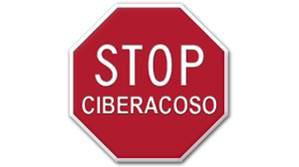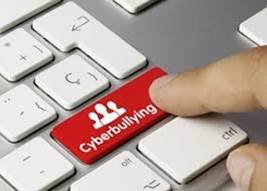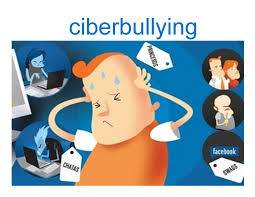Ciber Acoso - cyber bullying
Buenas Tarde queridos amigos, les traigo un tema bastante concurrente desde que la tecnología empezó a formar parte de nuestras vidas, tanto así que obviamos y dejamos pasar este tema tan Importante como el #CiberAcoso espero les sea de Mucha Ayuda y tengamos consciencia de los que puede causarnos tanto #Físico y #Mentalmente este tema involucra tanto Niños Como Adultos.

QUE ES EL CIBER ACOSO
El ciber acoso es el acoso que tiene lugar en dispositivos digitales, como teléfonos celulares, computadoras y tabletas. El ciber acoso puede ocurrir mediante mensajes de texto, textos y aplicaciones, o bien por Internet en las redes sociales, foros o juegos donde las personas pueden ver, participar o compartir contenido. El ciberacoso incluye enviar, publicar o compartir contenido negativo, perjudicial, falso, o cruel sobre otra persona. Esto puede incluir compartir información personal o privada sobre alguien más, provocándole humillación o vergüenza. Algunos acosos por Internet pasan a ser un comportamiento ilegal o criminal.
Los lugares más comunes donde ocurre el ciberacoso son:
- Redes sociales, como Facebook, Instagram, Snapchat y Twitter
- SMS (servicio de mensajes cortos), también conocidos como mensajes de texto, enviados a través de dispositivos
- Mensajería instantánea (a través de dispositivos, servicios de proveedores de email, aplicaciones y funciones de mensajería de las redes sociales)
TACTICAS DEL CIBER ACOSO
Es importante comprender cómo los niños son acosados por Internet para que sea más fácil reconocerlo y tomar medidas. Algunas de las tácticas de ciberacoso más comunes incluyen:
- Publicar comentarios o rumores sobre alguien en línea que son desagradables, perjudiciales o embarazosos.
- Amenazar con herir a alguien o decirle que se suicide.
- Publicar una foto o video hiriente o perjudicial.
- Pretender ser alguien más en línea para solicitar o publicar información personal o falsa sobre otra persona.
- Publicar nombres, comentarios o contenido desagradable o aborrecible sobre cualquier raza, religión, etnia u otras características personales en línea.
- Crear una página web desagradable o perjudicial sobre otra persona.
- "Doxing", una forma abreviada de los documentos escritos, es una forma de acoso en línea usado para vengarse y para amenazar y destruir la privacidad de las personas al hacer pública su información personal, que incluye direcciones, números de seguro social, tarjeta de crédito y teléfono, enlaces a cuentas de redes sociales y otros datos privados.
PREVENIR EL CIBER ACOSO
Sepa qué están haciendo sus hijos en Internet.
Un niño puede verse involucrado en el ciber acoso de distintas maneras. Puede padecer acoso, acosar a otros, o ser testigo de un acoso. Los padres, maestros y otros adultos pueden no estar al tanto de los medios digitales y las aplicaciones que el niño utiliza Cuantas más plataformas digitales utiliza un niño, se presentan más oportunidades de verse expuesto a un posible ciber acoso.
Preste atención: identifique si ha habido un cambio en el sentido del humor o el comportamiento y averigüe cuál puede habre sido la causa. Intente determinar si estos cambios en el niño ocurren como resultado del uso de dispositivos digitales.
- Hable: haga preguntas para saber qué está sucediendo, cuándo comenzó y quién está involucrado.
- Documente: lleve un registro de lo que está sucediendo y dónde ocurre. Haga una captura de pantalla de las publicaciones o los contenidos dañinos de ser posible. La mayoría de las leyes y las políticas dicen que el acoso es un comportamiento repetido, así que los registros ayudan a documentarlo.
- Denuncie: la mayoría de las plataformas de redes sociales y las escuelas tienen políticas claras y procesos de denuncia. Si un compañero de clases está acosando por Internet, denúncielo en la escuela. También puede contactarse con la aplicación o las plataformas de redes sociales para denunciar el contenido ofensivo y pedir que lo retiren. Si el niño ha recibido amenazas físicas o si ocurre un delito potencial o comportamiento ilegal, denuncie a la policía.
- Apoye: los compañeros, mentores y adultos de confianza pueden a veces intervenir públicamente para influenciar de manera positiva en una situación donde se publican contenidos negativos o dañinos sobre un niño. La intervención pública puede incluir la publicación de comentarios positivos acerca de la persona acosada para tratar de desviar la conversación hacia una dirección positiva, También puede servir para acercarse al niño acosador y al acosado para expresar su preocupación. De ser posible, trate de determinar si se necesita más apoyo profesional para dichas personas, como hablar con un consejero o un profesional de la salud mental.
No obviemos este tema tan importante como lo es para nuestra sociedad, aportemos cada quien un poco de valores para que día a día nuestra planeta crezca y sea mas respetado entre las personas, si yo pude tu también puedes

Good afternoon dear friends, I bring you a very concurrent theme since technology began to be part of our lives, so much so that we ignore and let go this important issue as #CiberAcoso I hope it will be a lot of help and we have awareness of those who It can cause us both # Physical and #Mentally this issue involves both Children and Adults.
** WHAT IS THE CIBER HARASSMENT **
Cyberbullying is the harassment that occurs on digital devices, such as cell phones, computers and tablets. Cyberbullying can occur through text messages, texts and applications, or through the Internet on social networks, forums or games where people can see, participate or share content. Cyberbullying includes sending, posting or sharing negative, harmful, false, or cruel content about another person. This may include sharing personal or private information about someone else, causing humiliation or embarrassment. Some Internet harassments become illegal or criminal behavior.
The most common places where cyberbullying occurs are:
- Social networks, such as Facebook, Instagram, Snapchat and Twitter
- SMS (short message service), also known as text messages, sent through devices
- Instant messaging (through devices, email providers services, applications and messaging functions of social networks)
** CIBER TACTICS HARASSMENT **
It is important to understand how children are harassed by the Internet so that it is easier to recognize and take action. Some of the most common cyberbullying tactics include:
- Post comments or rumors about someone online that are unpleasant, harmful or embarrassing.
- Threaten to hurt someone or tell them to commit suicide.
- Post a hurtful or harmful photo or video.
- Pretend to be someone else online to request or post personal or false information about another person.
- Publish names, comments or unpleasant or hateful content about any race, religion, ethnicity or other personal characteristics online.
- Create an unpleasant or harmful web page about another person.
- "Doxing", an abbreviated form of written documents, is a form of online harassment used to avenge and threaten and destroy the privacy of individuals by making public their personal information, which includes addresses, social security numbers, card of credit and telephone, links to social network accounts and other private data.
PREVENT CIBER HARASSMENT
Know what your children are doing on the Internet.
A child can be involved in cyber bullying in different ways. You may suffer harassment, harass others, or witness harassment. Parents, teachers and other adults may not be aware of the digital media and applications that the child uses. The more digital platforms a child uses, the more opportunities there are to be exposed to possible cyberbullying.
Pay attention: identify if there has been a change in the sense of humor or behavior and find out what may have been the cause. Try to determine if these changes in the child occur as a result of the use of digital devices.
- Speak: Ask questions to know what is happening, when it started and who is involved.
- Document: keep track of what is happening and where it occurs. Take a screenshot of publications or harmful content if possible. Most laws and policies say harassment is repeated behavior, so records help document it.
- Report: Most social media platforms and schools have clear policies and complaint processes. If a classmate is harassing you online, report it at school. You can also contact the application or social media platforms to report the offensive content and ask that it be removed. If the child has received physical threats or if a potential crime or illegal behavior occurs, report it to the police.
- Support: peers, mentors and trusted adults can sometimes intervene publicly to positively influence a situation where negative or harmful content is published about a child. Public intervention may include the publication of positive comments about the harassed person to try to divert the conversation in a positive direction. It may also serve to approach the harassing child and the harassed to express their concern. If possible, try to determine if more professional support is needed for such people, such as talking with a counselor or mental health professional.
We do not ignore this important issue as it is for our society, we each contribute a little bit of values so that every day our planet grows and is more respected among people, if I could you can also.

Congratulations @josephs8c! You received a personal award!
Click here to view your Board
Do not miss the last post from @steemitboard:
Congratulations @josephs8c! You received a personal award!
You can view your badges on your Steem Board and compare to others on the Steem Ranking
Vote for @Steemitboard as a witness to get one more award and increased upvotes!